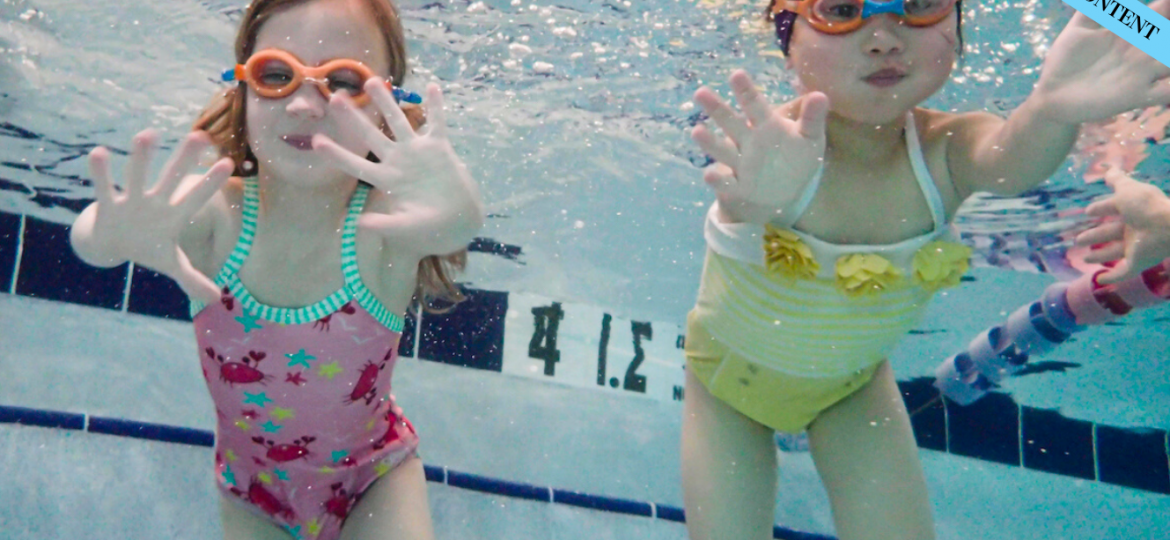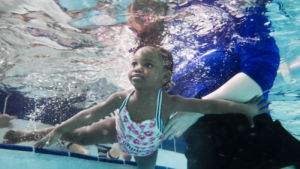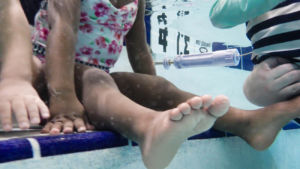
In partnership with Aqua-Tots.
Water is everywhere—the retention pond in the backyard, your next-door neighbor’s pool, your annual family vacation—everywhere. May is National Drowning Prevention Awareness Month, and though we may not know the immediate outlook for the reopening of public pools, water safety has never been more important. The combination of warming temperatures with our post-quarantine need to stretch our legs and soak up some sun means we’ll assuredly be rushing to whatever body of water we can feasibly get to. And, more than likely, many of the early-opening pools will not come with a dedicated lifeguard on duty.

It’s a (scary!) fact that drowning is the No. 1 cause of accidental injury-related death among children ages 1-4 and the No. 2 cause of death for children up to age 14, according to Centers For Disease Control and Prevention. To prepare you and your child for this year’s swim season, we sat down with Lindsay Thayer, owner of Aqua-Tots Swim School and mother of three. Lindsay discusses water safety, and how our families can prepare, even in the midst of COVID-19 restricting current access to pools and swim lessons.
What is the difference between being able to swim and water safety?
Being able to swim is the physical ability to put learned skills into action to independently move in the water with proper breath control, head and body position, and controlled movement. Being water-safe is a state of mind in having the awareness to respect boundaries in and around water. A child that is trained in water safety knows their capabilities and limitations, and respects them.
What is the number one factor impacting water safety?
Adult supervision is the most vitally important line of defense to drowning prevention. Unfortunately, 88 percent of child drownings occur with at least one adult present, according to the National Drowning Prevention Alliance (NDPA). That being said, a dedicated water watcher is the No. 1 factor in keeping kids safe around the water.
How do you talk to kids about water safety?
Our Aqua-Tots motto is, “Safety First, Fun Every Second.” We understand that kids’ main focus in water is to have fun, so we teach our students the Aqua-Tots pledge to engrain our safety-first mentality: “I promise to never swim without an adult or lifeguard, always enter the water feet-first, always walk around the pool, and always follow all pool safety rules.”
How do kids retain information regarding water safety?
Children will learn water safety skills like they do anything else, whether it be playing the piano, learning how to throw a baseball, or learning how to do a cartwheel. It takes repetition, practice away from instruction, and support from those around them. Swim lessons should be a priority year round, as water safety is not seasonal.
What essential skills should young children possess for basic water safety?

First and foremost, a young child needs to learn basic boundaries around the water. These include never approaching water without an adult, not throwing anything into the water, and knowing how to safely enter the pool or body of water. Once the boundaries are understood, the three most important life-saving skills every child should have are:
- How to comfortably control their breath underwater
- How to flip to their backs
- How to float on their back to rest and get air if they ever found themselves in danger
What are the biggest risks for children near a body of water?
Children are curious. Even knowing safe boundaries, curiosity gravitates a child toward water. If water is near, locked barriers are vital. One of the most “missed” water safety tactics is teaching your child to never throw a toy into water, as this is a temptation to then go in after it. Pool toys should be put away after use and kept in a safe place away from the water.
What are signs of distress or drowning?
Drowning claims the lives of more than 3,500 people every year in the United States alone, according to the Centers for Disease Control and Prevention. There is a common misconception that drowning begins with a splash and a coughing struggle. In fact, drowning is often silent and can happen as quickly as 20 seconds and in as little as two inches of water. It’s also important to remember drowning isn’t limited to pools and natural bodies of water, but can also in our homes, like the bathtub, sinks, etc.
How can families prepare for water safety at home without access to a pool?
Even when a pool is unavailable, parents and guardians should frequently discuss the importance of water safety. Bath time is a great time to practice being comfortable in the water and having water on their face, working on breath control, and floating on your back just to name a few. Watch our Aqua-Tots home edition videos here.
Once Aqua-Tots is able to re-open, what additional safety measures will be in place to protect families?
We have launched our Full Circle of Safety program with the health and safety of our families as our number one priority, as it always has been. The Full Circle of Safety includes four areas of focus, including, Customers, Staff, Facility, and Lessons/Procedures. With this program, we are implementing the use of PPE, health screenings for staff and customers, enhanced cleaning and sanitizing, social distancing per government guidelines, no-touch check-ins, electronic swim lesson feedback, and more.
This summer, water safety will more than likely be solely your responsibility. Heed Lindsay’s advice, and prepare yourselves for a summer of safety-first, fun every second with your little ones.
Aqua-Tots North Indianapolis is located on E. 96th Street, between Allisonville Road and Keystone Parkway.
Aqua-Tots Swim School Facebook

